603d Medical Clearing Company Unit History
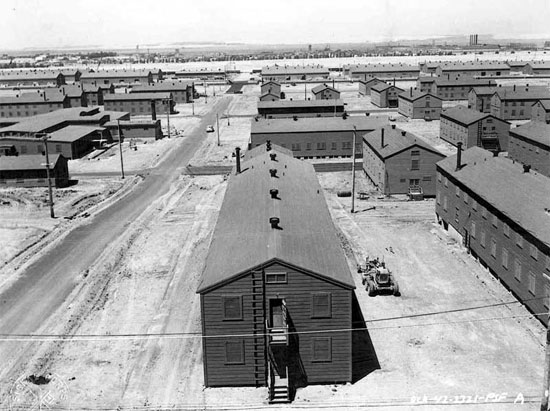
Partial view of Enlisted Men’s barracks, Cp. Stoneman, Pittsburg, California, Staging Area for the San Francisco Port of Embarkation. Picture taken in June 1942.
Introduction & Activation:
The 603d Medical Clearing Company (Separate) was organized on 1 September 1943 at the Central Oregon Maneuver Area, Bend, Oregon, Zone of Interior. Personnel were drawn almost entirely from D Company, 1st Medical Regiment (Medical Regiment, T/O 8-21, dated 1 April 1942, authorized strength, 78 Officers, 1 Warrant Officer, 1,078 Enlisted Men –ed), at the time of its re-organization as the 1st Medical Group. Subsequently to this, the 603d Med Clr Co (Sep) was attached to the 1st Med Gp, re-organized as per T/O & E 8-28, dated 20 May 1943. On 20 December 1944, the unit was re-organized in accordance with T/O & E 8-28, dated 4 September 1944. The organization was detached from the 1st Medical Group on departure from the continental United States 13 January 1944.
(Medical Clearing Company (Separate), T/O 8-28 & E, dated 1 April 1942, aggregate strength; 17 Officers & 184 Enlisted Men –ed) – Medical Clearing Company (Separate), T/O 8-28 & E, dated 20 May 1943, authorized strength; 13 Officers & 104 EM).
At 1 January 1944, effective strength was 13 Officers & 104 EM, which would decrease to 13 Officers and 97 EM by 31 December 1944.
Early History & Training:

Field classes are being taught during Training in the Zone of Interior. Military Sanitation and First Aid teaches a soldier not only how to keep himself healthy, but also what to do in case of emergency until the doctor comes …
The unit was re-designated the 603d Medical Clearing Company (Separate) per Paragraph 1, General Orders # 78, IV Army Corps, Office of the Commanding General, dated 31 August 1943, with an initial authorized strength of 10 Officers and 115 Enlisted Men. The organization was changed to two Platoons (Third Platoon was re-designated Second Platoon, and 46 EM transferred to other organizations) and also comprised Company Headquarters.
Between 3 September and 3 November 1943, the unit participated in numerous tactical field exercises in the Oregon Maneuver Area, including movements, change of stations, setup of Clearing Stations at different locations, day and night movements, bivouacs, and intensive physical training and conditioning (the latter continuing until practically end of November). The exercises were part of a large scale military training held in central Oregon in 1943 and was designed to test US Army units prior to deployment overseas. The maneuver included approximately 100,000 men belonging to units pertaining to IV Corps commanded by Major General Alexander M. Patch, Jr. (with Headquarters located at Camp Abbott, south of Bend, Oregon -ed). The Maneuver included five specific training problems. Following the end of these maneuvers, the 3 major participating units; 91st Infantry Division, 96th Infantry Division, and 104th Infantry Division subsequently prepared for movement overseas, being sent to combat in both the European and Pacific Theaters.
The 603d left the Oregon Maneuver Area at 0525 hours, 3 November 1943, traveling 201 miles of roads in good order, fair weather, and superior morale.
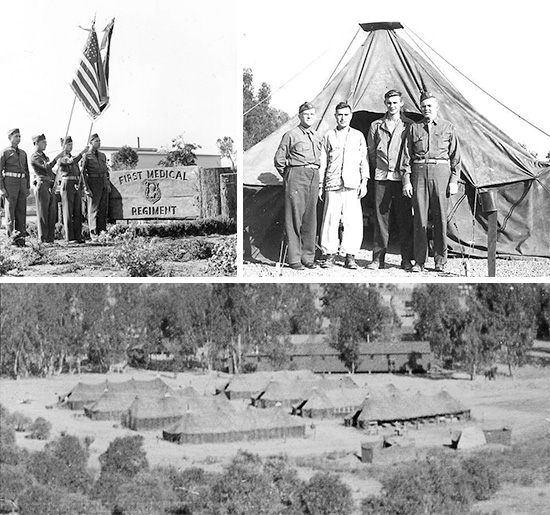
Top Left: Official Flag Ceremony, 1st Medical Regiment, La Mesa, California, December 1942.
Top Right: Picture of Pat Corbett, two patients, and Glenn E. Turner, in front of a M-1934 Pyramidal Tent, D Company, 1st Medical Regiment, La Mesa, California, December 1942.
Bottom: 1st Medical Regiment set up under tentage at La Mesa, California, some time in 1942.
1 January 1944 found the Company located at Camp White, Medford, Oregon (Division Camp, acreage 49,638, troop capacity 1,884 Officers and 35,557 Enlisted Men –ed) where it started preparations for movement overseas. The stay was short as the next day the organization moved by rail to Camp Stoneman, Pittsburg, California (Staging Area for San Francisco Port of Embarkation, acreage 3,242, troop capacity 2,604 Officers and 35,607 Enlisted Men –ed) where it arrived on 3 January for further processing.
Zone of Interior Stations – 603d Medical Clearing Company (Separate)
Wagontire, Oregon Maneuver Area (1 Sep 43 > 3 Sep 43)
Lava Butte, Oregon Maneuver Area (6 Sep 43 > 9 Sep 43)
Millican, Oregon Maneuver Area (10 Sep 43 > 13 Sep 43)
Brothers, Oregon Maneuver Area (20 Sep 43 > 21 Sep 43)
Suntex, Oregon Maneuver Area (21 Sep 43 > 27 Sep 43)
Gray Butte, Oregon Maneuver Area (29 Sep 43 > 1 Oct 43)
Buffalo, Oregon Maneuver Area (6 Oct 43 > 7 Oct 43)
Fort Rock, Oregon Maneuver Area (14 Oct 43 > 16 Oct 43)
Hampton, Oregon Maneuver Area (17 Oct 43 > 18 Oct 43)
Sisters, Oregon Maneuver Area (19 Oct 43 > 25 Oct 43)
Redmond, Oregon Maneuver Area (31 Oct 43 > 3 Nov 43)
Movement Overseas:
After due processing and further POM procedures the unit moved from Camp Stoneman to the Port of Embarkation Staging Area in San Francisco on 11 January. After a short ferry ride down the harbor, the San Francisco Pier was reached where the 603d boarded the USS “Mount Vernon” on 12 January (AP-22, formerly the luxury ocean liner S/S Washington, commissioned 16 June 1941 and used for troop transportation in the Pacific and European Theaters –ed). The ship was commanded by Captain E. P. Eldredge, USN.
The 603d Medical Clearing Company (Separate) left the Zone of Interior on 13 January 1944 with destination New Guinea.
New Guinea:
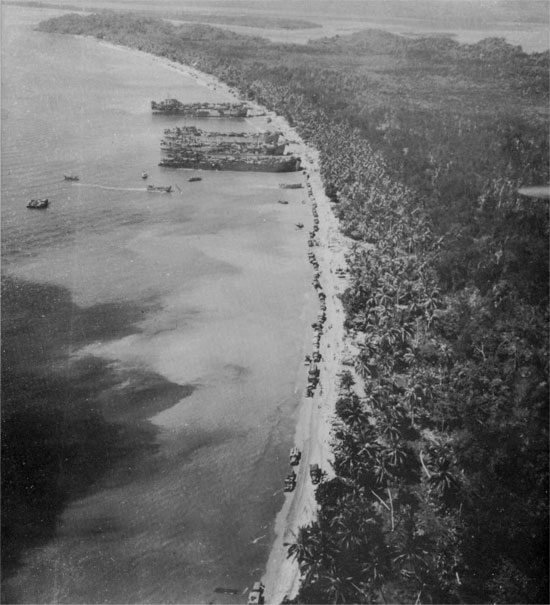
Aerial view of Milne Bay, New Guinea located at the eastern tip of the Papuan Peninsula. Base “A”, one of the 8 USASOS bases supporting operations in the region and later in the Philippines was located at Milne Bay and would develop a peak in medical activities during 1944.
The organization arrived in New Guinea 29 January 1944 after an uneventful sea voyage and debarked during night at Ahioma, Milne Bay, New Guinea, on 1 February 1944. After re-assembly and re-organization, the 603d moved from Ahioma to K.B. Mission, Milne Bay on 13 February.
Pursuant to new orders emanating from Sixth US Army, the unit having obtained supplies of classes 1, 2 and 4, sufficient for thirty days, departed from Milne Bay 2 March 1944, boarding LST # 67 for Buna, New Guinea, the next day, which it reached on 4 March. After arriving at Cape Sudest, the company landed and moved by motor convoy to the bivouac area at Oro Bay (Base “B”) where they were informed of their mission: to provide medical support and service as directed to units in the Admiralty Islands Group (Brewer Task Force). On 6 March they boarded LST # 66, embarking with the TF, comprised of the 1st Cavalry Brigade (part of 1st Cavalry Division –ed) and attached units (at this time the 603d Med Clr Co (Sep) consisted of 13 Off & 104 EM –ed).
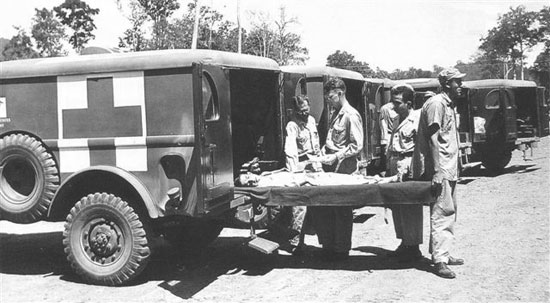
Ambulance unloading somewhere in New Guinea. Litter patients are being detrucked and carried to the nearest Hospital for treatment.
Admiralty Islands Group:
The TF sailed from Oro Bay on 7 March and landed at “Red Beach”, Los Negros Island, on 9 March 1944. The area had been previously secured by other units of the 1st Cavalry Division. Subsequent operations by tactical units were devoted to the successive clearing on Los Negros, Manus, and adjoining islands of enemy strongpoints. The 603d set up a Clearing Station on 10 March at a site 100 yards east of “Red Beach” (where it remained until 18 May 1944, inclusive –ed), and started treating predominantly surgical cases, reaching a census on one occasion of 240 patients. Some of the instructions underlined the equipment and supplies to accompany the movement such as: heavy tentage, folding cots with mosquito bars, anti-malaria supplies, and 3 units of fire for all weapons (mainly .45 cal. auto pistols and .30 cal M1 carbines).
Until 21 March, when Unit “A” of the 58th Evacuation Hospital began operation (it arrived 6 March 1944 –ed), seriously ill or wounded patients were evacuated to Finschhafen or Oro Bay by sea (by Navy destroyer and LST) or air transport (C-47, B-17, or B-25). During this operation the Company was assigned code 1051-J.
The patient census in March 1944 was 543, and the one in April 1944 amounted to 444 (including 26 injured and 44 battle casualties). The dispensary mainly treated small units stationed nearby or in the area with first echelon medical care, performing 5,129 treatments between March and May 1944.

Partial view of Clearing Station established by the 603d Medical Clearing Company in the area of “Red Beach”, Los Negros Island, Philippines, between 10 March and 18 May 1944.
Major James E. Murphy, MC, O-382383, commanded the Company during this period. On 6 May 1944, orders were received relieving the CO and transferring him to the 1st Medical Squadron (1st Cavalry Division). He was replaced by Major Louis W. Soland, MC, O-357258, coming from Headquarters, 1st Cavalry Division, who was assigned to the 603d and joined the organization as per Special Orders # 18, dated 27 April 1944,
On 22 May, the 603d was instructed by verbal orders to move its Clearing Station from “Red Beach” to the north border of the Salami Plantation, approximately one mile from 1st Cavalry Division Headquarters. Here, a much superior area had been prepared, incorporating definite improvements for patient comfort and sanitation. Ward tents were mounted on log supports, the area graveled, a crude oil garbage incinerator was installed, screened latrines were set up, a drained four-outlet shower built, screened mess and kitchen provided, a chapel and a theater built, all contributing to the general comfort and well-being of patients and hospital personnel. Bed capacity was 138 with an additional two wards erected in reserve. Occupancy ranged from 60% to 85%. Patient census in May was 314 (including 25 injured and only 3 battle casualties), reaching 285 (including 26 injured and 2 battle casualties) in June 1944.
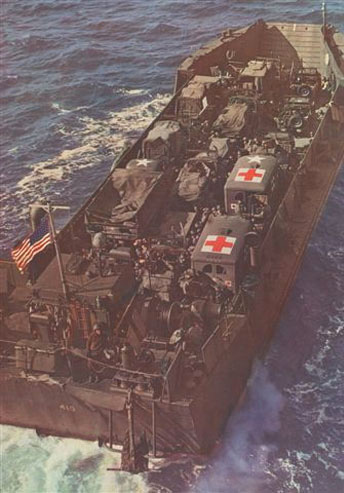
Somewhere in the Pacific region. LCT (5) on its way to supply its load of vehicles and equipment including two Army WC-54 3/4-Ton Ambulances.
Tec 5 Clifford Scott, ASN 17049657, was awarded a Bronze Star Medal for heroic service behind enemy lines to bring aid and assistance to injured natives, while stationed on Los Negros Island, Admiralty Group, during the Bismarck Archipelago Campaign.
Leyte Island, Philippines:
The organization staged on Los Negros Island, for the “King II” Operation and was therefore assigned to Sixth United States Army (CG > Lt. General Walter Krueger –ed) and attached to the 1st Cavalry Division. 6 October 1944, the Company boarded the USS “Leonard Wood” (APA-12, participated in the Leyte, Lingayen Gulf, and Mindoro operations –ed) which finally departed Seeadler Harbor, Manus Island, on 12 October. Movement was uneventful with the unit landing at “White Beach”, Leyte Island, Philippines, on 20 October 1944, at H + 5. There was no opposition on the beachhead but unit equipment could not be collected until late in the evening resulting in a temporary Clearing Station being set up in rice paddies about 150 yards inland. The unit also helped establish a medical dump in the neighborhood. Medical support was mainly dedicated to the 8th Cavalry Regiment. Initial casualties received were few, mostly civilians. US Navy fighters landed nearby for emergency landings. Air raids were frequent. The Station was closed 23 October and the organization moved on to Tacloban by motor convoy to bivouac near a large schoolhouse. Twenty-eight (28) severe civilian casualties were immediately admitted and treated. The Clearing Station later moved (30 October –ed) to a better site (race track) recently vacated by other American troops.

Personnel of the 603d Medical Clearing Company aboard APA-12 “Leonard Wood” on their way to Leyte Island, Philippines, October 1944.
The Company was relieved from the 1st Cavalry Division on 1 November 1944 and attached to X Army Corps, after which it moved to Barrio San Vicente, on Highway # 42, where the area was grassy and dry, overlooking a small stream. Daily census reached 150 of which 10% were surgical cases and 90% medical. Casualties were from the 24th Infantry Division. Evacuation was to the 36th Evacuation Hospital at Palo.
The Station at San Vicente closed on 10 November while Second Platoon moved to Carigara to set up a Clearing Station in a large church, where the remainder of the Company joined them the following day. There was room for 100 patients and just to make sure for any cases of emergency, 6 ward tents were pitched in courts within the church yard for accommodating another 100 patients. Personnel lived under tentage in an adjoining field. Admissions were mainly from the 24th Infantry – 32d Infantry – and 1st Cavalry Divisions – the 112th Cavalry RCT, and smaller X Army Corps units. They also included other outfits as the 38th Infantry Division, the 92d Filipino Division, members of local guerrilla forces, civilians, and a few wounded coming from the 77th and 96th Infantry Divisions of XXIV Army Corps. Roads for evacuation were almost impassible which meant that the only efficient method was to bring patients to Carigara beach by landing barges, DUKWs, and small boats. Inland, an Ambulance Control Point was set up by the 407th Medical Collecting Company (Separate). Evacuees went to the 1st Field Hospital, the 2d Field Hospital, the 58th Evacuation Hospital, and occasionally to the 36th Evacuation Hospital and the 400th Medical Collecting Company. It must be noted that the 603d was the most forward medical unit in the area.
Between 20 October and 25 December 1944, a total of 2,236 patients were admitted, of which about 25% were battle casualties necessitating approximately 30% surgery. Disposition of over half the patients was to duty. Among the medical cases, malaria was the highest, and in order to provide for a minimum of laboratory work microscopes were borrowed from the 28th Malaria Survey Unit and the 107th Medical Battalion. No acute N-P problems were discovered. However, there was a marked increase in anxiety states following severe enemy shelling.
The Station was finally closed 6 January 1945. The unit then left Carigara and moved to “White Beach”, near Tacloban, by motor convoy where personnel boarded two different vessels on 25 January; USS “Haskell” (APA-117, attack transport which served in Lingayen Gulf and Luzon –ed) and USS “Capricornus” (AKA-57, attack cargo which participated in the invasion of Leyte, Okinawa and Japan –ed). The convoy left San Pedro Harbor being now attached to XI Army Corps for the new operation. About 2 ½ tons of unit supplies, clinical records, and tentage were not bulk-loaded by the 3d Battalion of the 34th Infantry Regiment as planned, and were therefore lost.

First US Flag planted on the beach on D-Day, 20 October 1944. This could illustrate “White Beach”, Leyte Island, Philippines, following the landing.
During the campaign medical supply was adequate and whole blood and penicillin were used with good results. Food shortages did occasionally occur with lack of fresh eggs and meat. In peak periods personnel was supplemented by female civilian nurses and Filipino civilian labor details. The American Red Cross, as well as personnel of the 12th Special Service Company and the 35th Malaria Control Unit were very cooperative. 35 Japanese PWs were treated and afterwards evacuated to the rear.
Losses in action: Tec 5 Louis G. Boucher, ASN 36218410, was slightly wounded in action at Carigara, Leyte Island, during the Philippine Liberation Campaign, but was later returned to duty.
Luzon Island, Philippines:
The 603d Medical Clearing Company (Separate) landed unopposed at “Blue Beach”, near San Antonio, Zambales Province, Luzon Island, on 29 January 1945 at H + 4. After moving inland it opened its Clearing Station at San Antonio (abandoned school building) on 30 January becoming fully operational on 1 February 1945. In this operation, the Company operated as a Corps Clearing Station on behalf of XI Army Corps. Combat troops served included the 38th Infantry Division and the 34th Regimental Combat Team.
On 3 February, Headquarters Section and Second Platoon proceeded by motor convoy two miles NE of Olangapo, Subic Bay, Luzon Island, to establish a Clearing Station in a rice field adjoining Highway # 7, where it was joined by First Platoon the next day. Activities took place around ZigZag Pass. Being located three hundred yards in front of a heavy artillery installation, patients and personnel were unfortunately disturbed by the constant noise and concussion. Operations closed on 18 February and on 20 February 1945, the entire unit moved by motor convoy to Orani, Bataan Province, Luzon Island, where a new Clearing Station was set up on 21 February.
While at Olangapo, the 1st Portable Surgical Hospital worked in conjunction with the 603d to which it was attached from 5 February until 16 February. Evacuation was to the 36th Evacuation Hospital through the 679th Medical Collecting Company (Separate); and when stationed at Orani (set up in a wooden schoolhouse), evacuees went to the 894th Medical Clearing Company (Separate) and to the 36th Evacuation Hospital. Medical cases included 22 patients suffering from malaria and 42 cases with infectious hepatitis. 1 neuro-psychiatric case was treated. Medical supply was adequate, food was sufficient and good.

“War On Flies”, the sign reads: starve them by not opening coconuts. The reason is that open and discarded coconuts collected water in which malarial mosquitoes bred. The picture was taken in 1942 in the PTO and illustrates Bluejackets bathing their feet in a chemical solution to prevent Athlete’s Foot.
Operational plans changed constantly during the period, due to the often rapid change in the overall tactical situation. The 603d was not the only medical unit supporting and servicing XI Army Corps. Other organic and attached units included were Company “D”, 262d Medical Battalion, elements of the 592d Engineer Boat & Shore Regiment, the 3d Field Hospital, 227th Station Hospital, and the 1st, 18th and 64th Portable Surgical Hospitals.
On 3 March, the Company departed Orani for a new site located one mile SE of Castellijos, Zambales Province to replace the 36th Evacuation and the 3d Field Hospitals. On 5 March it took over the remaining 250 patients and the facilities which included a women’s and childrens’ ward and in which a civilian physician was employed. Evacuation was often accomplished by use of L-5 planes and ambulances pertaining to the 679th Medical Collecting Company (Separate), located at Olangapo. Operations closed on 20 March 1945 with all patients being transferred to Company “A”, 262d Medical Battalion. Most of the direct admissions during the above period were acute medical cases with a rising proportion of hepatitis. Malaria was moderately prevalent; N-P cases were few.

Left: View of the destroyed Post Office building in Manila, Capital city of the Philippines.
Right: View of one of the destroyed bridges over the Pasig River. Both pictures taken May-June 1945.
21 March 1945, the 603d Medical Clearing Company (Separate) moved by motor convoy to Manila, Capital City of the Philippines, where it came under direct control of the Commanding General, Sixth United States Army. After having profited from some relaxation in a bivouac area in Manila the unit boarded LST # 1034 in accordance with Authorization Letter, Headquarters, Sixth United States Army, for the purpose of joining at Mindoro Island, Philippines, other units preparing for the V-5 (Victor Five) operation. The date was 1 April 1945.
Mindoro Island, Philippines:
The convoy left Manila Bay 3 April 1945. After an uneventful voyage, the 603d landed at “White Beach”, Mindoro Island, on 4 April 1945. Bivouac was established near the 13th Station Hospital, about two miles from San José. The organization was now relieved from assignment to Sixth US Army and assigned to Eighth United States Army (CG > Lt. General Robert L. Eichelberger –ed) as per Paragraph 33, General Orders No. 57, Headquarters Sixth United States Army, Subject: Assignment of Units, effective 4 April 1945. The 603d was re-attached to the 24th Infantry Division the following day.
On 10 April, a surgical team comprising 2 Officers and 5 Enlisted Men were temporarily attached to the 247th General Hospital. On 12 April 1945, Headquarters and Second Platoon and the afore-mentioned surgical team boarded LST # 631, while First Platoon boarded LST # 992. The convoy left the harbor at Mindoro Island 14 April, reaching Polloc Harbor 17 April. On 18 and 19 April 1945, the two groups debarked at Parang, Mindanao Island (they were now attached directly to X Army Corps).
Mindanao Island, Philippines:
On 21 April, First Platoon moved from Parang to Malabang, Mindanao Island, and on 22 April 1945 established a 100-bed Clearing Station near the airstrip to serve local American units and assist in air evacuation; they were supported by three ambulances with drivers and orderlies attached from the 395th Medical Collecting Company. The same day, Company Headquarters and Second Platoon left Parang for Cotobato where they established a Clearing Station 23 April. The only troops present included elements of the 187th Engineer Aviation Battalion and personnel of the 116th Antiaircraft Artillery Group. Main activities in the area centered around the airstrip operated by Marine Corps Air Group # 24. Patients were brought to Malabang by L-5 light planes, by C-47 cargo planes, and even by fighter planes. It was already closed on 26 April after transferring the remaining patients to the 263d Medical Battalion which assumed operation at this site. On 30 April, Second Platoon departed Parang by amphibious shipping (LSM) with an attached surgical team from the 247th General Hospital, as part of a force scheduled to land at Digos (Davao Harbor), about 25 miles south of Davao. Company Headquarters returned to Parang, awaiting transportation to Malabang (site of an advanced airstrip) which they finally reached by 5 May enabling them to join First Platoon.
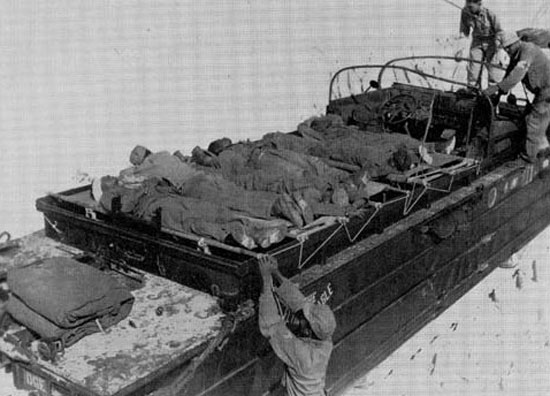
Patients are being loaded into a DUKW, for evacuation by waterways, often one of the only means of evacuation in a tropical jungle environment.
During the month of May, the Company functioned in a manner different from the methods employed in other campaigns. Previously it had operated as a single unit giving close medical support to combat troops. During May 1945 each Platoon operated independently with one out of the immediate combat area. Second Platoon closed its station on 21 May 1945 and moved on to Libby airfield where it assumed functions similar to First Platoon, evacuating about 400 patients off the island.
Patients arrived from the following installations: Company “A”, 263d Medical Battalion – 24th Infantry Division Clearing Station – 656th Medical Clearing Company (Separate) – 30th Evacuation Hospital – 99th Evacuation Hospital – 52d Field Hospital – 90th Field Hospital – 172d Station Hospital – 361st Station Hospital. Patients were evacuated to the 603d, either by L-5 or LCM and PT-Boats and were sent off Mindanao by C-47 to APO 702, overland evacuation being impossible.
During the months of June and July 1945, Headquarters and First Platoon continued to function as a hospital on the Malabang airstrip, receiving patients for air evacuation and admitting others for treatment, finally closing on 31 July. Second Platoon was still operating at the Libby airstrip until 27 July, at which time it ceased operations. There was less surgery than before, but the incidence of fever, diarrhea, gastro-enteritis, malaria, hepatitis, respiratory and skin diseases continued as usual. No unusual cases of neuro-psychiatry were met. The necessary medical supplies were adequate, being received from the 74th Medical Depot and the 24th Division Medical Supply.

Technician 3d Grade Glenn E. Turner, in front of the unit’s “Surgery” tent.
Cebu Island, Philippines:
On 28 July 1945, Second Platoon boarded LST # 6 at Tuloma, Mindanao Island, departing the next day for Cebu, Island, arriving at Danao, Cebu Island on 2 August. On 2 August 1945, Headquarters and First Platoon boarded LSM # 150 at “Red Beach” and left the next day for Cebu, arriving at Cebu City on 4 August and joining Second Platoon in bivouac four miles south of Danao, Cebu Island. At this time, the Company was released from Eighth US Army control and passed to Sixth United States Army jurisdiction. Because of loss of personnel under Readjustment & Redeployment Regulations, the organization arrived at Cebu much under strength (only 65%). Effective 1 August 1945, the organization was assigned to Sixth US Army, attached to IX Army Corps, and later re-attached to the 77th Infantry Division. It was subsequently further attached to the 302d Medical Battalion (organic medical unit 77th Infantry Division –ed), as per Section 7, General Orders, No. 278, Headquarters, 77th Infantry Division, dated 11 August 1945. Effective 15 August, the unit reverted to Eighth United States Army control, with no change in attachment. The period from 1 to 30 September 1945 was spent in bivouac re-supply and training for Redeployment being undertaken. At this time the organization did not operate a hospital. Only dispensary service was furnished for unit personnel.
Japan:

“The Road to Tokyo & Beyond”. Booklet published by the Office of War Information containing the 3d Report to the President, the Senate, and the House of Representatives, presented by the Director of War Mobilization and Reconversion, dated June 30, 1945. Major conclusion: “Faces Turned West – The primary task facing the Nation today is to win the War in Japan – to win it completely and as quickly as possible.”
On 23 September 1945 the 603d Medical Clearing Company (Separate) boarded APA-213, USS “Mountrail” (APA-213, attack transport which participated in operations against Leyte, Luzon, Okinawa, Japan and China –ed) in Cebu Harbor, Cebu Island, and departed on 25 September for Hakodate, Hokkaido Island, Japan.
The 603d debarked at Hakodate on 4 October 1945 and set up a Hospital in a steel and concrete three-story school building in the center of town. It was established in conjunction with the 68th and 95th Portable Surgical Hospitals (assignment and attachment remained unchanged). Its main function was to furnish medical care for the personnel of the Hakodate Task Force consisting of the 306th Infantry Regiment, 77th Infantry Division, the Divisional Artillery, and other small attached units. Ambulance service was maintained by the 409th Medical Collecting Company and later in October by Company “B” of the 302d Medical Battalion. The entire Company remained together. On 31 October both the 68th and 95th Portable Surgical Hospitals were inactivated and their entire personnel assigned to Company “B”, 302d Medical Battalion, but in effect they were placed on special duty with the 603d Med Clr Co.
The organization was hard hit by the RR-1 Regulations and by 10 November 1945 overall strength had dropped to 13 EM assigned (11 present for duty), and 4 Officers assigned (with only 3 present for duty)! Replacements gradually started coming in by the end of November with Enlisted strength fluctuating between 50% and 66% of T/O authorized strength. The replacements coming directly from Infantry organizations were largely inexperienced in medical skills and training. Routine medical cases were treated with 743 patients admitted during the last quarter of 1945 and evacuation made by rail to the 76th Field Hospital located at Sapporo. After the 30th Evacuation Hospital was established in Sapporo, all cases were evacuated to it, except VD patients who were still sent to the 76th Field Hospital. Maximum bed capacity was 160, with average 30% occupancy.
By mid-January 1946 the 603d had gradually replaced personnel lost through the previous quarter until it was operating at about 70% Enlisted strength. The number of Officers however remained critically low, there being only 4 of them on duty. The organization was supplemented by 3 Officers and approximately 20 EM on special duty from Company “B”, 302d Medical Battalion. By the end of January personnel was once more down to 50% of its authorized EM.
On 16 February 1946, Officers and EM pertaining to the unit were transferred and assigned to the 29th Evacuation Hospital, APO 928, per Paragraph 9 & 10, Special Orders No. 39, Headquarters IX Army Corps, APO 309, until effective date of inactivation.
During this brief period, the total number of patients cared for gradually diminished. This was due to the loss of personnel in the HTF and also due to the gradual inactivation of organic units of the 77th Infantry Division. Total number of patients was 401, with 302 disease cases and 99 injuries. Bed occupancy barely reached 20%. Medical problems mainly consisted of upper-respiratory infections brought about by the change of climate, a few cases of malaria, and an occasional routine case of diarrhea, hepatitis, skin disease, and other common medical problems.
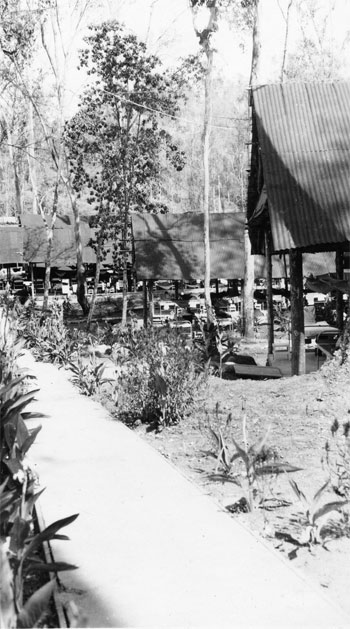
Partial view of medical installations pertaining to a General Hospital in the SWPA.
The 603d Medical Clearing Company (Separate) was officially inactivated in Japan 28 February 1946.
Southwest Pacific Region Operations:
At no time, except in a few minor occasions, were Company Headquarters and First Platoon in proximity to the frontlines. Because of the terrain features and great distances, evacuation was almost entirely by air and by water, not only because of the isolated areas in which the organization operated, but also due to the extremely poor roads and the absence of bridges.
Civilian labor was only utilized for short periods. There were often thefts, particularly of M1 carbines (wanted for hunting) and some equipment and clothing. Relations with civilians were normal, but uncordial with the Moros who were completely independent and largely uncooperative to the point of committing banditry, necessitating armed guards at the medical installations. Second Platoon suffered more inconveniences being confronted with minefields, difficult evacuation, ambush, and infiltration by enemy soldiers, which required placing outposts manned by regular American Infantry or Philippine Army soldiers. Because of this their 100-bed capacity was often under pressure to accommodate 150-190 patients. Surgical cases here were largely battle casualties and for a large time the unit was without a Dental Officer. There was no marked incidence of types of N-P diseases, and when numbers increased it was probably the effect of being too long in combat without rest.
The incidence of fever of undetermined origin, diarrhea, gastro-enteritis, malaria, infestations, respiratory diseases, hepatitis, was normal and not higher than usual. A fracture table was built and other field improvisations implemented. Atabrine and mosquito net discipline were maintained at all times. Hospital laundry was handled by attached or nearby QM Laundry Platoon personnel, if not available it was done by the unit’s personnel or sent away for exchange. Diesel fuel and DDT were used to control flies and mosquitoes, and to burn human and other waste
Water supply was always adequate and in most cases showers were set up. The quantity, quality, and nutritional value of the food was adequate, and occasionally fresh meat, butter, eggs and local fruits were obtained through QMC services or from local sources. As the climate was hot and humid, skin diseases were more common than usual. Ice was at times available and was used to refrigerate whole blood and penicillin. Unfortunately the refrigerator was taken away later and never replaced.
Equipment and supplies were kept off the ground to avoid deterioration. Medical supplies were adequate but some of the requisitions were very difficult to obtain because of the many changes of stations, leading to some necessary improvisations.
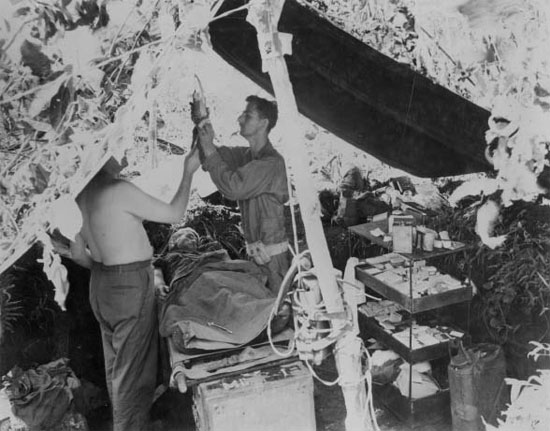
Administering Blood Plasma under a makeshift dressing station in the field.
Japan Operations:
The period lasting from 4 October 1945 to 28 February 1946 was one of reduced activity. The available bed capacity was never fully in use and there was rarely over 30% occupancy. Surgical cases received were relatively few, with only occasional fractures, sprains, and appendectomies. Since there was no x-ray facility, all fractures and severe sprains had to be evacuated. Due to climatic changes (from tropical, hot and humid climate to a cold and humid climate) upper-respiratory infections were very common. After stopping distribution of atabrine, malaria cases re-appeared within 4-6 weeks. Only two cases of neuro-psychiatry were recorded but many cases of VD among Task Force troops were noted. A dental clinic was installed with routine fillings, extractions and surveys being performed. At first evacuations took place once a week, but after receiving a dedicated hospital railcar from IX Corps, these were increased to three times a week. All patients likely to be hospitalized over 14 days were evacuated. Although the total number of patients cared for was never excessive, the untrained new replacements required more supervision from the limited available staff.
Water supply at the hospital building was adequate with daily supply of chlorinated drinking water. Hot and cold city water was available for showers and washing. DDT was efficiently used to control flies and mosquitoes. Indoor latrines were of the flush-type. Medical supplies were requisitioned and received through the 77th Infantry Division; they were adequate and arrived in good condition. A force of 20 Japanese civilians was employed for maintenance including boilermen, janitors, engineers, and general workmen.
A large public school gymnasium was secured for basketball, PT and other games. A Chaplain was temporarily assigned to the unit to conduct services each Sunday. A motion picture projector was obtained so that movies could be shown three or four times a week for patients and personnel.
The last two weeks of February 1946 were devoted to packing and turning in equipment and supplies and closing out the organization’s records.
Assignments & Attachments – 603d Medical Clearing Company (Separate)
Attached to 1st Medical Group (ZI 1 Sep 43 > 3 Jan 44)
Assigned to Sixth United States Army & Eighth United States Army (AFWESPAC 29 Jan 44 > 28 Feb 46)
Attached to X Army Corps (20 Oct 44 > 20 Apr 45)
Attached to XI Army Corps (6 Jan 45 > 21 Mar 45)
Attached to IX Army Corps (1 Aug 45 > 28 Feb 46)
Attached to 1st Cavalry Division (7 Mar 44 > 19 Oct 44)
Attached to 24th Infantry Division (5 Apr 45 > 20 Apr 45)
Attached to 77th Infantry Division (7 Aug 45 > 28 Feb 46)

Men are bringing in 5-Gallon Water Cans collected at a water supply point to their position. Hauling water was essential and in order to avoid any health risks, it was usually chlorinated before consumption.
Overseas Stations – 603d Medical Clearing Company (Separate)
Ahioma, Milne Bay, New Guinea (1 Feb 44 > 13 Feb 44)
Buna, New Guinea (3 Mar 44)
Oro Bay, New Guinea (4 Mar 44 > 6 Mar 44)
Los Negros, Admiralty Islands (9 Mar 44 > 5 Oct 44)
Leyte Island, Philippines (20 Oct 44 > 23 Oct 44)
Tacloban, Leyte Island (31 Oct 44)
San Vicente, Leyte Island (1 Nov 44 > 10 Nov 44)
Carigara, Leyte Island (10 Nov 44 > 6 Jan 45)
San Antonio, Luzon Island (30 Jan 45 > 2 Feb 45)
Olangapo, Luzon Island (4 Feb 45 > 19 Feb 45)
Orani, Luzon Island (21 Feb 45 > 3 Mar 45)
Castellijos, Luzon Island (5 Mar 45 > 20 Mar 45)
Manila, Luzon Island (21 Mar 45 > 1 Apr 45)
San José, Mindoro Island (4 Apr 45 > 14 Apr 45)
Parang, Mindanao Island (19 Apr 45 > 20 Apr 45)
Malabang, Mindanao Island (22 Apr 45 > 31 Jul 45)
Cotabato, Mindanao Island (23 Apr 45 > 26 Apr 45)
Santa Cruz, Mindanao Island (3 May 45 > 10 May 45)
Danao, Cebu Island (10 May 45 > 21 May 45)
Cebu City, Cebu Island (2 Aug 45 > 23 Sep 45)
Hakodate, Hokkaido Island, Japan (4 Oct 45 > 28 Feb 46)

View illustrating the Altar of the Roman Catholic Church where the 603d Medical Clearing Company set up its station (site unknown).
Key Officers Roster: (incomplete)
Major Rafael R. Camso, MC, O-344569 (CO 20 Aug 44 > 5 Jun 45)
Major James E. Murphy, MC, O-451683 (CO 1 Sep 43 > 2 May 44) (CO 28 May 44 > 29 May 44)
Major Louis W. Soland, MC, O-357258 (CO 5 May 44 > 28 May 44) (CO 29 May 44 > 4 Aug 44)
Captain John H. Amesse, MC, O-26435
Captain John E. Harroun, MC, ? (CO 1 Aug 45 > 28 Feb 46)
Captain Emanuel Herzon, MC, O-435335
Captain Thomas J. Kelley, MC, O-414928
Captain Harold H. Kettell, DC, O-395062
Captain Stanley J. Klimek, MAC, O-1533605
Captain Hugh M. Kopel, DC, O-1755407
Captain Thornton S. McIntire, MC, O-464579 (CO 15 Apr 44 > 1 Aug 44)
Captain Richard J. Phillips, DC, O-1702784
Captain Raymond M. Reichle, MC, O-419478 (CO 4 Aug 44 > 20 Aug 44)
Captain Irvin L. Whetsell, ChC, O-509759
1st Lieutenant George W. Corner, Jr., MC, O-435219
1st Lieutenant Joseph A. Dugas, MC, O-1683233
1st Lieutenant Edward B. Kinports, MC, O-435482
1st Lieutenant Murray O. Lorenz, MAC, O-451683
1st Lieutenant Russell T. Shilling, ChC, O-207134
2d Lieutenant Josper L. Jensen, MAC, O-2007455
2d Lieutenant Isaac F. Miller, MAC, O-2007453
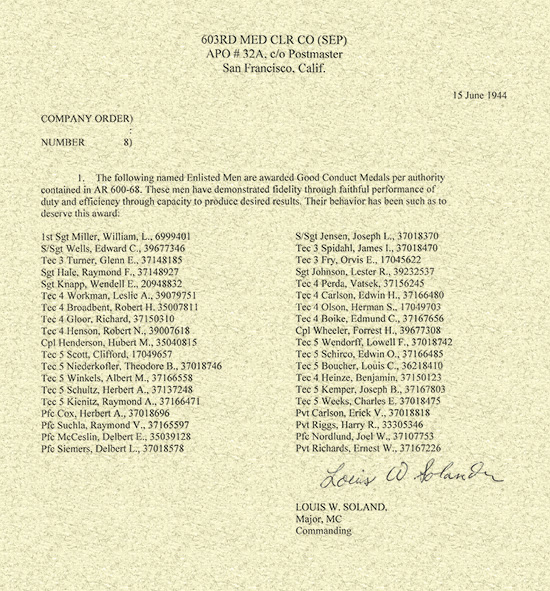
Company Order No. 8 (dated 15 June 1944) officially awarding selected Enlisted Men of the 603d Medical Clearing Company the Good Conduct Medal.
Courtesy of Glenda Hadley.
Campaign Credits – 603d Medical Clearing Company (Separate)
New Guinea
Admiralty Islands
Bismarck Archipelago
Leyte
Southern Philippines
(authorized one bronze star on Asiatic-Pacific Theater Ribbon, per GO # 26, USAFFE, dated 11 Feb 45)
(authorized second bronze star on Asiatic-Pacific Theater Ribbon, per GO # 100, USAFFE, dated 28 Apr 45)
(authorized third bronze star on Asiatic-Pacific Theater Ribbon, per GO # ???, USAFFE, dated ??? 45)
(authorized Philippine Liberation Ribbon + 2 bronze stars, per GO # 23, USAFFE, dated 5 Feb 45)

Photograph of Glenn E. Turner, 37148185, US Army Medical Department 2 March 1942 > 1 December 1945.
The MRC staff truly appreciate the assistance provided by Lynn McNulty, son of WW2 Veteran Captain Frederick J. McNulty (ASN: O-526873) who generously donated a number of historical reports relating to the 603d Medical Clearing Company (Separate) which served in the Pacific Theater. Special thanks are also due to Glenda Hadley, daughter of Surgical Technician 3d Grade Glenn E. Turner (ASN:37148185) for providing some extra data and pictures related to her Father’s service with subject unit. The MRC staff are still looking for a complete Personnel Roster of the unit as well as data relating to its last activities overseas and eventual return to the Zone of Interior.
